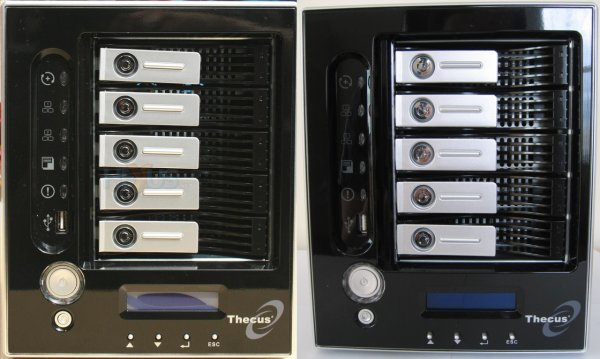N5200 Pro - closer look
N5200 on steroids
Making this reviewer's life easy, Thecus's additions to the N5200 are such that our previous N5200 non-Pro review serves as an excellent point of reference, so make sure you've had a flick through that if you're unfamiliar with the N5200.
Nothing like a review that's easy to write! But make no mistake, there are differences and they're worth your attention.
Let's have a look at the specs of the N5200 and N5200 Pro together, shall we?
| Feature | N5200 | N5200 PRO |
|---|---|---|
| CPU | Intel Celeron M 600MHz | Intel Celeron M 1.5GHz |
| Memory | 256MiB DDR | 512MiB DDR |
| HDDs | 5 x 3.5" SATA II HDD, hot-swappable | |
| eSATA port | 1 x eSATA connector for capacity expansion | |
| USB ports | 2 x USB A type (host mode) 1 x USB B type (client mode) |
|
| Ethernet ports | N5200: 2 x Gigabit RJ-45 connectors N5200 RouStor: 1 x Gigabit RJ-45 connector & four-port Gigabit switch |
|
| LCD control panel | For basic configurations and status display | |
| Network file protocols | Microsoft Networks (CIFS/SMB) Apple Filing Protocol (AFP 3) Network File System (NFS v3) File Transfer Protocol (FTP) Hyper Text Transfer Protocol (HTTP) Secure Hyper Text Transfer Protocol (HTTPs) |
Microsoft Networks (CIFS/SMB) Apple Filing Protocol (AFP 3) Network File System (NFS v3) File Transfer Protocol (FTP) Hyper Text Transfer Protocol (HTTP) Secure Hyper Text Transfer Protocol (HTTPs) iSCSI |
| Authentication | Microsoft NT Domain Controller (PDC) Microsoft Active Directory Authentication (AD) |
|
| Network client type | Microsoft Windows NT/2000/XP/2003/Vista Unix/Linux/BSD MAC OS X, OS 9, OS 8.6 |
|
| Network configuration | Fixed IP address Dynamic IP address |
|
| Disk management | Power management (Disk idle spin-down) Self-Monitoring, Analysis, and Reporting Technology (S.M.A.R.T.) |
|
| RAID | RAID 0, 1, 5, 6, 10, and JBOD Auto rebuild Hot wwappable Hot spare Disk roaming RAID level migration RAID expansion |
RAID 0, 1, 5, 6, 10, and JBOD Auto rebuild Hot swappable Hot spare Disk roaming RAID level migration RAID expansion Multiple RAID entities |
| Disk capacity supported | 80/120/160/200/250/300/400/500/750 GiB | |
| Folder management | Share folder level permission File level permission Public folder |
|
| Quota management | Share folder quota control | |
| Backup | Snapshot Thecus Backup Utility (Microsoft Windows XP/2000 /MAC OS X) Thecus Nsync |
|
| System management | Web GUI Multilingual support (English, French, German, Italian, traditional Chinese, simplified Chinese, Japanese, Korean, Spanish) |
Web GUI Multilingual support (English, French, German, Italian, traditional Chinese, simplified Chinese, Japanese, Korean, Spanish) Shutdown/startup scheduling Wake-On-LAN |
| Event notification | Email notification Buzzer notification LCD |
|
| Supported USB devices | USB printer External HDD/Flash disk USB IEEE 802.11 b/g dongle w/ AP mode support |
|
| Setup utility | Windows 2000 / XP / 2003 MAC OS X |
|
| Safety and environment | CE, FCC, BSMI, C-Tick, RoHS-compliant | |
| Dimension | 230 x 190 x 230 mm (H x W x D) | |
| Physical security | Kensington Lock security hole Lockable disk tray |
|
| Operating environment | 0ºC - 40ºC 20 – 85% Relative humidity (non-condensing) |
|
| Power supply | Server-rated AC power supply 100/220VAC, 50/60 Hz, auto detect |
|
We snuck mention of iSCSI in under "file protocols", although in reality it operates at block-level. More on that a little later.
The specs table tells us that, on the surface, the N5200 and N5200 Pro are very much alike, though Thecus has beefed up the CPU and RAM to the same as those you'll find in its 1U4500 rackmount NAS. It's also and added a few new features to the firmware, most notably iSCSI and support for more than one RAID entity.
It's not all about looks
Using the dark art of digital image editing, we can show you an image of the N5200 (left) alongside an N5200 Pro.
Gaze closely upon the two products, and identify - if you can - the differences between them. You might struggle, though, because, from the front, they are identical.
Indeed, there's nothing different at all about the two, externally, bar one thing, and that has nothing to do with the non-Pro/Pro relationship. The N5200 we reviewed was a RouStor edition, featuring a four-port Gigabit switch. The N5200 Pro on review today just has two GigE ports. So, around the back, we have one RJ-45 port where once there was a bank of four.
Internally, we can see the N5200 v2.0 motherboard, used in all N5200s and the 1U4500s. Sat in it are a 1.5GHz Celeron CPU and 512MiB of DDR RAM. A 128MiB flash module holds the Linux-based operating system for the device.
And that's about all there is to mention in terms of physical features. Check out our N5200 review for a closer look.
Build quality
A solid steel chassis surrounds the N5200 Pro hardware, with metal drive cages for each disk too. We experienced some issues getting our 750GB 7200.10 Seagate drives to spin up - sometimes having to remove and reinsert them. At first we were concerned it was a manufacturing issue with the N5200 Pro or its drive cages.
We contacted Thecus and were advised that the company had also seen this issue with this particular model of disk but that other disks, for example Hitachi's 1TB models, didn't show the same symptoms. Thecus hinted that the Seagate 7200.10s weren't too keen on hot-plugging.
We'd suggest, then, that users consider avoiding 7200.10 disks, or contact Thecus for more information.












